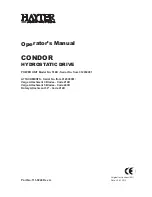
Disassembly/Reassembly Procedures
: Ensuring Radio Submergibility
8-41
8.7.8
Pressure Test (using NTN4265_)
Pressure testing the radio is necessary only if the radio has failed the vacuum test. Do not perform
the test until the vacuum test has been completed. Pressure test involves creating sealed condition
inside the radio, submerging the radio in water, and observing the radio for a stream of bubbles
(leak). Since all areas of the radio are being checked, observe the entire unit carefully for the
possibility of multiple leaks before completing this test.
NOTES:
When Radio is placed under the water there will be some air trapped which will be released.
This is not a failure.
Refer to the exploded view diagrams and parts lists found in
To conduct the pressure test:
1. Observe is there is any torn on the Main O-ring and battery contact seal.
2. Ensure that the front kit and back kits are assembled properly.
3. Attach the pressure test fixture onto the vacuum port of the radio as shown in
4. Attach one end of the hose to the pressure pump. Attach the other side of the hose to the
pressure test fixture (P/N: TL000062A01).
5. Operate the pump until the gauge reads approximately 1 psig.
Figure 8-56. Attaching Pressure Test Fixture
6. Maintain the pressure around 1 psig and submerge the radio in a water-filled container.
Pressure must remain between 0.5 psig and 1.5 psig.
Pressure lower than 0.5 psig may allow water into the radio,
which will damage the radio.
Ensure that the pressure NEVER exceeds 1.5 psig. The radio
has pressure sensitive components that can be damaged if
the pressure exceeds this limit.
!
C a u t i o n
!
C a u t i o n
Summary of Contents for APX 4000
Page 1: ...APXTM TWO WAY RADIOS APX 1000 APX 2000 APX 4000 APX 4000Li BASIC SERVICE MANUAL ...
Page 6: ...Notes iv Commercial Warranty ...
Page 8: ...ii Notes ...
Page 16: ...x Portable Radio Model Numbering System Notes ...
Page 46: ...3 12 Basic Theory of Operation Controller Section Notes ...
Page 60: ...5 12 Performance Checks Transmitter Performance Checks Notes ...
Page 128: ...8 34 Disassembly Reassembly Procedures Ensuring Radio Submergibility Notes ...
Page 142: ...Index 4 Index Notes ...
Page 144: ...ii Notes ...
Page 150: ...viii List of Figures Notes ...
Page 152: ...x Portable Radio Model Numbering System Notes ...
Page 240: ...7 32 Disassembly Reassembly Procedures Ensuring Reliable Splash Protection Notes ...
Page 250: ...9 6 Exploded Views and Parts Lists APX 1000 Back Kit Exploded View Parts List Notes ...
Page 254: ...Index 4 Index Notes ...
Page 255: ...Title Page ASTRO APX 1000 Digital Portable Radios Section 3 900 MHz APX 1000 ...
Page 256: ......
Page 262: ...viii List of Figures Notes ...
Page 264: ...x Portable Radio Model Numbering System Notes ...
Page 278: ...3 8 Basic Theory of Operation Controller Section Notes ...
Page 336: ...7 32 Disassembly Reassembly Procedures Ensuring Reliable Splash Protection Notes ...
Page 346: ...9 6 Exploded Views and Parts Lists APX 1000 Back Kit Exploded View Parts List Notes ...
Page 350: ...Index 4 Index Notes ...
Page 352: ...ii Notes ...
Page 360: ...x Portable Radio Model Numbering System Notes ...
Page 400: ...5 12 Performance Checks Transmitter Performance Checks Notes ...
Page 428: ...6 28 Radio Alignment Procedures Performance Testing Notes ...
Page 434: ...7 6 Encryption Erase an Encryption Key Notes ...
Page 478: ...8 44 Disassembly Reassembly Procedures Ensuring Radio Submergibility Notes ...
Page 490: ...ii Notes ...
Page 492: ...A 2 Accessories Notes ...
Page 496: ...Notes B 4 EMEA Warranty Service and Technical Support Further Assistance From Motorola ...
Page 520: ...Glossary 12 Glossary Notes ...
Page 524: ...Index 4 Index Notes ...
Page 525: ......
















































